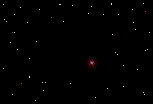


  |
| |
|
(courtesy of Anglo-Australian Observatory (AAO))
Discovered 1780 by Charles Messier. Messier 65 (M65, NGC 3623), together with its neighbors M66 and NGC 3628, forms a most conspicuous triplet of galaxies, the Leo Triplett or M66 group, located at a distance of about 35 million light years. Although it is close to and thus under the gravitational influence of its neighbors, M65 looks like a very "normal" Sa type spiral and seems to have felt little influence. It has a prominent central lense and tightly wound spiral arms, plus a prominent dust lane marking the facing edge. The luminous disk is dominated by a smooth old stellar population. Near the lane, some knots are visible, which, according to J.D. Wray, may be associated with star forming regions. The lane may hide regions of star formation usually associated with such features in spiral galaxies. Our image of M65 was obtained by David Malin with the Anglo-Australian Telescope of the Australian Astronomical Observatory; interested readers may obtain more detailed information on our image. M65, together with its neighbor, M66, has been discovered by Charles Messier, who cataloged it on March 1, 1780, describes it as "very faint nebula without stars." Because of a dubious error, Admiral Smyth has assigned this discovery of M65 and M66 (and M68) to Pierre Méchain, a view which was adopted by Kenneth Glyn Jones somewhen in the 1960s, and consequently, in many sources, despite the fact that Messier doesn't acknowledge such a prior sighting, which he did in all other cases. Halton Arp includes M65 in his entry number 317 of his Catalogue of Peculiar Galaxies, which denotes the Leo Triplett. Only one supernova has been discovered in M65 so far: Supernova 2013am, which was found by M. Sugano on March 21, 2013, located 15.3" east and 103.2" south of the center of this galaxy. Sugano found its magnitude at that time at 15.6, which almost coincides with the brightest values found days later. From its spectrum, this supernova was found to be of type II. To April 17, it had faded to mag 16.3. (Credits to SEDS - Students for the Exploration and Development of Space) | |
Observer´s Log Galaxy |
| ||||
This site was last updated 2019-02-10 Site created and maintained by Jorge Lázaro |